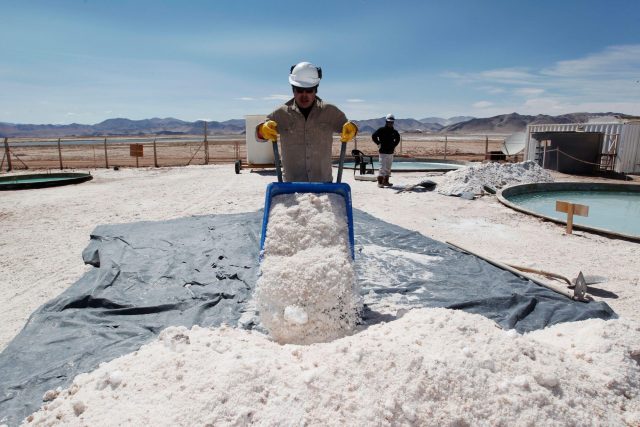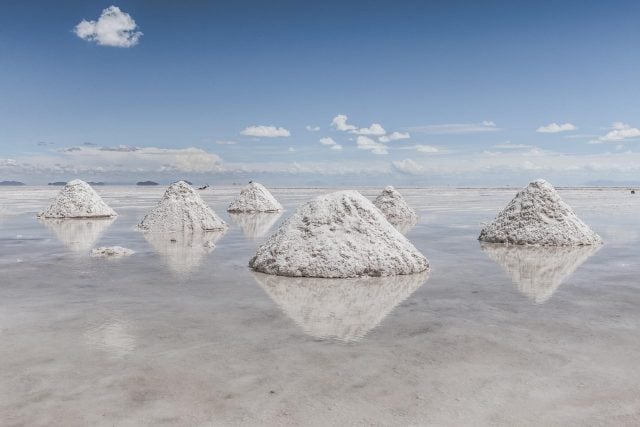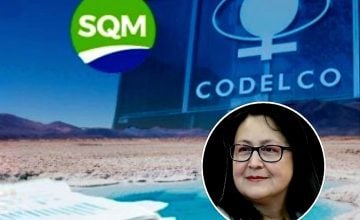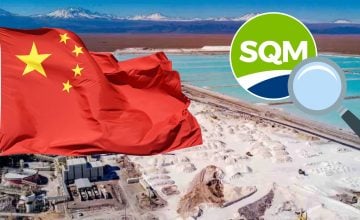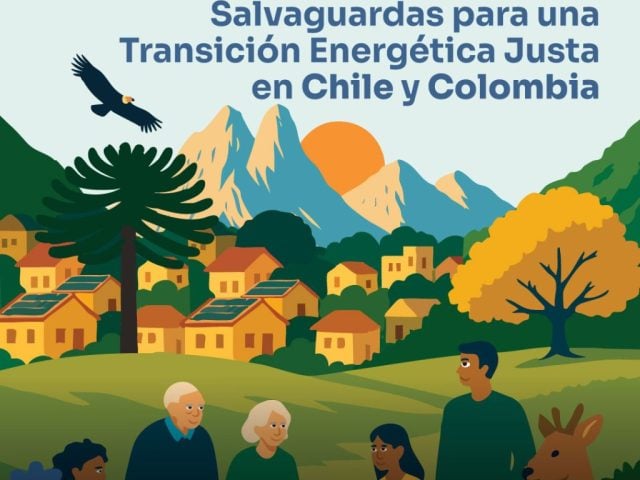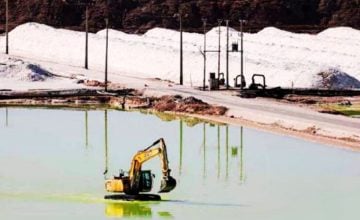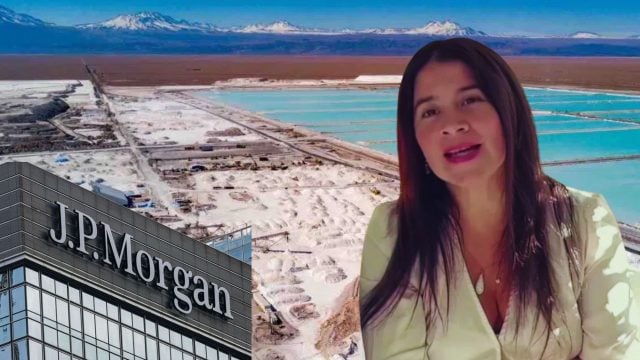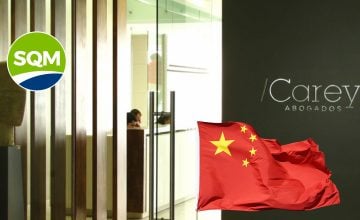Lithium is a mineral that has been considered «essential» for electric cars and batteries. It is associated with the so-called «energy transition», a false solution promoted by companies and governments against the climate crisis.
In Catamarca there are at least 18 lithium projects that are in different stages: prospecting, initial and advanced exploration, feasibility and production. It seems that lithium is indeed the new gold of the so-called “energy transition”.
Although it is often advertised as “clean energy”, lithium extraction implies overconsumption of water sources, use of polluting chemicals, displacement of populations and an ‘invasion’ quite similar to the colonization era.
Argentine legislation does not recognize the «strategic» nature of lithium, allowing the private sector to access public deposits through an ordinary mining concession and dispose of them freely to sell, lease, mortgage or exploit them until they are exhausted, with the rhythm, the scale and the environmental consequences they want.
That is why today, in the face of growing international demand, direct extractive investments are rushing to acquire rights to the salt flats, including the large global lithium corporations, such as Chile’s SQM, controlled by Pinochet’s former son-in-law, Ponce Lerou, which cannot expand its exploitation in the Atacama salt flat for being the protagonist of the biggest corruption scandals in the history of Chile.
Next, we share a report from the “Tierra Viva” News Agency: ‘The salt of the earth, Antofagasta de la Sierra and the looting of lithium’ by Susie Maresca
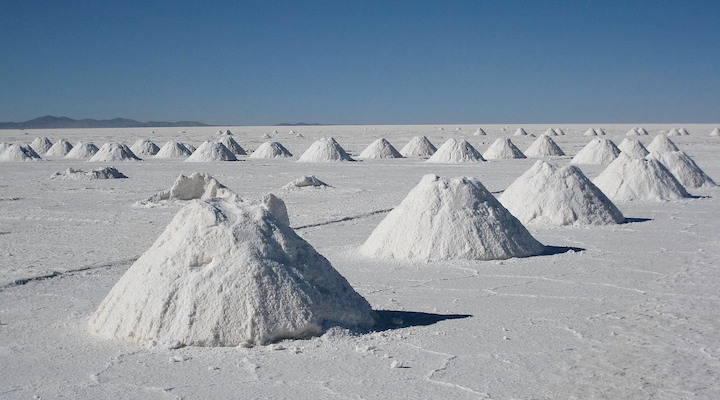
The real “lithium triangle”
More than 25 years ago, the Fénix project began in the Salar del Hombre Muerto, 97 kilometers from the town of Antofagasta de la Sierra, along Provincial Route 43. It is a lithium mega-extraction project in the salt flats. Lithium carbonate and/or chloride, ulexite and, above all, water are extracted.
The first company was Minera del Altiplano, currently Livent, based in the United States and belonging to the FMC Lithium corporation.
Verónica Gostissa, a lawyer specializing in environmental law, and member of the Pucará assembly (Catamarca Peoples in Resistance and Self-determination) recounts: “This project has high levels of extraction that have begun to take a turn in recent years due to the so-called energy transition. Once again the dynamic between the global north and the global south is that of the looting of the common goods of the countries of the south to sustain this energy transition of the north with a very high and irreparable environmental cost”.
In this energy transition that wants to leave behind the use of hydrocarbons and fossil fuels, there are some fundamental stakeholders. According to the newspaper La Nación, “as of 2022, Argentina will become the second largest producer of lithium in the world, only behind Australia. The car company BMW signed a multimillion-dollar contract with Livent, but it is not the only one, there is also the American multinational Tesla», that produces electric cars.
In April 2021, the national government together with the governors of the provinces of Jujuy, Salta and Catamarca inaugurated the Lithium Roundtable. «The objective is to promote the development of this key sector for the NOA and the industrialization of raw materials in the country», the Lithium Roundtable points out. Again, Argentina producer of raw materials at the expense of the populations and water. Once again, it ignores the communities, their demands and needs, once again turning the country into a zone of sacrifice in exchange for a few dollars and an eternal debt.
In the international context, Livent with the Fénix project decided to double its production, to which eight companies with eight projects in different states are added. One of the largest is that of Galaxy Resources Ltd, with the project called «Sal de vida», a company that has just merged with the Oro Cobre company in August 2021, the same company that extracts lithium in Jujuy with complaints from the communities due to contamination and lack of public consultation. Both companies are of Australian origin merged into Allkem.
The companies Posco Argentina, a multinational of Korean origin, and Alpha Litihum corporation, half Australian and US, are also present.
The Ministry of Mining of Catamarca indicates at least fifteen lithium extraction projects. Some of them operate on indigenous territories of the Atacameños del Altiplano community. Although national laws establish that free, prior and informed consent must be obtained from the communities, none of this is fulfilled.
For the Pucará assembly, the so-called «lithium triangle» made up of Argentina, Chile and Bolivia, is not the real triangle. “The true triangle of lithium is the enormous link between the security forces, the State and the multinational companies”, they summarize.
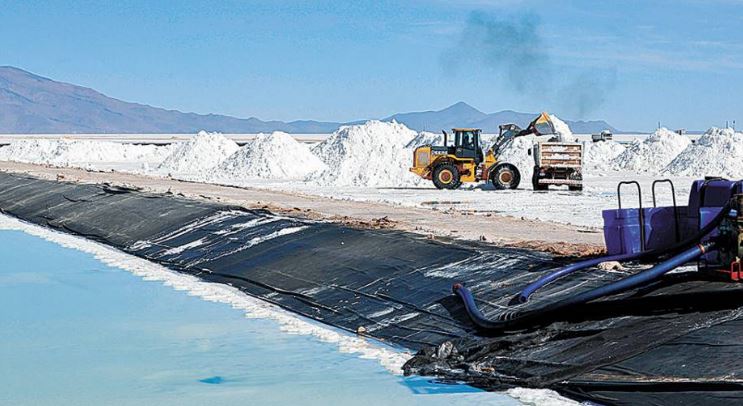
‘The dead man’
In the Salar del Hombre Muerto (Dead man salt flat), life and death merge and at times the limits are imperceptible. For others, they are overwhelming. Large emerald-green lagoons with an acid and fetid smell, that from afar seem like a lifeless paradise. Where the polluted waters are, there is not a single animal and the few places where the water still shines, like in the Los Patos River, there are birds everywhere. For Román Guitián, the 42-year-old cacique of the Atacameño Diaguita indigenous community of the Altiplano, a road crossed his home and his land, where his ancestors are.
The “dead man”, which gives the name to the salt flat, was called that way because of the human remains found by his great-grandfather. “The large tomb is that of my great-grandfather and the small one is the famous tomb of the dead man, which my great-grandfather found at the end of anhydrite (a crystalline mineral found in the area), brought him here and buried him. He asked to be buried beside him and there he is. These are ancestral lands, many generations of my family have lived here. All our lives. Here lived my great-grandfather who was the father of my grandmother and my grandmother who was the mother of my mother. They lived and died here. They’re here. They were dedicated to livestock, trout fishing in the Los Patos River and to farming the land”, says Román.
Formerly the salt flat was a place of exchange with other communities. The salt that was abundant, and that today is scarce, was an input to exchange for wool and meat.
International conventions and unfulfilled laws
The salt flat, whose system of lagoons is threatened by mining activity, is more than 4,000 meters high in the Andes Mountains but does not form part of the system of High Andean and Punean Lagoons, protected since 2009 by the Ramsar Convention for the international conservation of the wetlands. The exclusion was not accidental: it was an express decision of the governor of Catamarca in 2008, Eduardo Brizuela del Moral, which facilitated the advance of extractive activities.
The reform of the National Constitution of 1994, in addition to giving away the territories to multinational companies, recognized the ethnic and cultural pre-existence of the indigenous peoples and the community property rights with respect to the lands they have traditionally occupied, as well as the right to administer natural resources. The right to possession of the land implies that it cannot be alienated, transferable, nor subject to encumbrances or seizures. In addition, the State adhered to international agreements such as the Inter-American Charter of Human Rights and the United Nations Declaration on the Rights of Indigenous Peoples (Dnudpi).
In 2000, Argentina ratified ILO Convention 169 on indigenous and tribal peoples, an agreement of a supralegal nature, superior to national law. It establishes that indigenous peoples must be consulted regarding any legislative or administrative measure that involves them, and that this is the responsibility of the State. In relation to extractive activities, it emphasizes that consultations must take place before any approval of an exploration or exploitation. This never happened, denounces Verónica Gostissa.
«Since the company arrived, there is a lot of death»
Camilo Condorí is 63 years old, with hardened hands and a desire to die in his land. They installed the plant of the Livent company about 1,000 meters from his house and now they want him to leave to make more brine ponds. They cut his land in half with a mining road, just like they did to the cacique, and they put a padlock on the gate that connects with his family’s house. To visit his mother, he has to ask permission from the company.
Camilo rides a bike. He will not leave his land. He resists.
Among other promises, he says that they told him that they would reopen the road to his mother’s house. But they did not comply.
“I used to drink water from a spring that is natural, freshwater, near the salt flat. Now it’s been a while since I’ve been going there because it started to make me sick. My eyes burn and I start to feel bad. They built a well for me here that is barely for washing clothes and for bathing, for nothing else. It is not for consumption. They say that this water is not contaminated (points to the lagoon) but if I drink it I get sick. Because we are born, raised here. Before, there was no steam, there was nothing. Now, in the morning there is smoke, a vapor, as if it were boiled water. But they say it has nothing”, he explains.
—What was the road like and what happened?
—Before it was a straight path, wherever you wanted to go, everything was calm, there was no bother of anything. And now, since the company arrived, there is a lot of death, you see everything that they have uprooted (points to the grasslands that they have uprooted).
—The company suggested that you leave here?
—Yes, even the Intendant himself wants one to leave here. Make room for the company. They are all… how do you say? Pimps. Nobody is in favor of us, only him (points to cacique Román) but he is from here so… Few people are angry about this. How is a company going to come from elsewhere to get me out of here? He has said it (Román), there is no need to give up… Where am I going to go? Elsewhere? No, we don’t have to go away from here.
—And how is your health?»
—I’m a little bit unwell. It hurts up here (Head). The last time I went to the doctor was for the New Year. I have been vomiting, weakness. I take aspirin that a doctor has prescribed for me so that I don’t have a stroke.
—What was your field like before the company arrived?
—And well, it was everything, there were animals. But after they fenced the land, you can no longer have a farm. The plain was large (he refers to the Trapiche River, which is dry due to mega-mining). That path (he points out) belonged to everyone here, but now they have done it just for themselves. Nooo, they are tremendous, we are up to the fight. When are you going to make them understand? If we have health we can fight.
Román Guitián adds: “The wetland, where they dump the plant waste into fresh water, is 50 meters away. That water that they throw from the waste of the plant is thrown into the salt flat. In the plain is the well of water where we have drawn, all our life, the water to drink. This mining company, since it started, has always dumped the water there. With what they call an equalizer, they say that they lower the PH, but those are lies because this water has never, since we live here, been that color and when it just dawns it starts to release steam and all that never happened before. That is why we say that this water is contaminated. But we cannot do an analysis because we do not have the chain of custody where we can take it to a safe laboratory to do the studies and check it. Our word is worthless».
The dry Trapiche river and the aqueduct for the mining companies
Another of the great current problems in the salt flat is that the companies (Galaxy and Livent) want to build a 35-kilometer aqueduct and the works have already begun. The aqueduct runs from the Los Patos river to the company’s plant.
Patricia Marconi, a biologist with a doctorate in hydrographic basin management and co-founder of the Yuchán Foundation, states: “One of the immediate impacts on the extraction of fresh water for lithium processing, in the first years of the installation of the Fénix Project, was the complete desiccation of the dam built on the Trapiche River, which involved the loss of between 16 and 20 hectares of fertile plains, a vegetal formation that requires permanent flood conditions and is one of the places with the highest primary productivity. Grazing area for domestic camelids, llamas and vicuñas. The average water extraction (from the mining company) is 650,000 cubic meters per hour, every day”.
The Yuchán Foundation, which has been working since 1996 through a program made up of specialists from Argentina, Bolivia, Chile and Peru, had access to the environmental impact reports requested by the Catamarca Environment Secretariat. Patricia Marconi points out that the environmental impact studies are presented as if they were unique projects in the basin, they do not mention the other companies, except to say that the area is very successful in terms of the quality of lithium obtained. The companies do not relate the use that all of them are going to make of the same resource (the brine that is extracted from the salt flat and later taken to evaporation ponds to obtain a brine concentrate that is later processed, as well as the fresh water that they obtain from the rivers for the process of the mineral).
What is called cumulative and synergistic impacts is not taken into account, despite the fact that, based on a resolution of the Federal Mining Council (Cofemin), the three provinces of the northwest that are involved (Jujuy, Salta and Catamarca) promised to take into account these impacts.
The biologist points out that less than one percent of the fresh water on the planet is available and of that one percent, 97 percent is groundwater. In the Puna it is found in aquifers at different depths. In this context, this type of mining is a water mega mining process since it is estimated that it consumes between one and two million liters of water per ton of final lithium carbonate.
“The proportion of fresh water is very high. In the case of the Fénix Project, with the requested flows, these 650,000 liters per hour represent what the city of Antofagasta de la Sierra consumes in 14 days. This is to measure the incidence that this type of extractive activity has on fresh water in a territory that is a high-altitude desert, extremely arid where it rains less than one hundred millimeters a year and where the natural water balance (the amount of water that enters the system by rain, snow, thaws and the amount of water that leaves the natural system by evaporation is seven out of each one that enters) is negative. How is it compensated? With groundwater that appears through rivers, in lagoons that are the bottoms of these closed basins or endorheic basins”, explains Marconi.
Violence against the residents and the community
Hugo Calpanchay is part of the Atacameños del Altiplano community and he smiles. Receiving friendly visits is quite an event. He is 36 years old and gets up at 5 in the morning to feed his sheep. He chooses to take his photo in front of a shed that he recently built with the plastics that fly from the mining company’s pools and that he collects as a recycler from the Puna.
“There were several episodes of criminalization, legal cases and police persecution, as a way to silence the voices that began to emerge after so many years of silence and tolerance of the advance of the extractive activities of companies, the accumulation of wealth and, therefore, the destruction of the salar and its territories”, says Verónica Gostissa.
Hugo was accused of threatening to set the company on fire. He was arrested in 2019 and the case is still open, without evidence. “When it became known what happened to me, what they did to me, a psychologist from the company came and they took me to the doctor, to be treated. Now, they only bring me alfalfa for the sheep from time to time, nothing grows here. They want us to leave, but we are still here because this is our land”, he recalls.
The person in charge of this case was prosecutor Jorge Alberto Flores, dismissed from his position in May because of irregularities with a company that was in the name of his wife, and was a supplier of food to the mining company.
Patricia Reinoso, a teacher at a school in Antofagasta de la Sierra, was sued and she spent a whole year without receiving her salary, fired from her position as a teacher, for the sole fact of accompanying the defense of the Salar.
The Morales family has a land title that is more than a hundred years old. And they also suffered police harassment. It was after the mayor, Julio Taritolay, decided that the mining trucks and immense machines would cross the ancestral lands of the Morales.
The mining companies needed to go through there, a road next to the town, so that the neighbors would not see the immense pipes that went towards the Salar to make the aqueduct of the Los Patos River.
Santiago and Alfredo Morales replaced the fences containing their animals and the police came to cut them down without any order, they said they were sent by the prosecutor Flores and the Mayor Taritolay. They detained Santiago, his partner with heart problems and a sister, who was beaten when she was taken into custody. They were accused of resisting authority and, after two years, the case is still open.
Mondays of souls
Eli Mamani has two daughters (Ludmila, 19, and Naiara, 9). She is also part of the Atacameños del Altiplano community and Alfredo’s partner for 25 years. A fighter for life, she emigrated from Salta in search of her father and she found in Antofagasta a place that she believed was safe for her family.
Today, she thinks about how to get ahead, she participates in talks, she gets together with the other women in the cemetery on Mondays, because it is the day of souls. She wants them to organize themselves to share knowledge and be able to set up a micro-entrepreneurship of fabrics.
“Some know how to spin, others on the loom, I like to weave”, she points out. Together with her family, once a week they make bread and biscuits to sell. She says that she is not against mining, but against the enormous pollution they leave behind, against the unfulfilled promises of jobs that never come, against young people with no future who have to leave to study or find decent jobs. She loves being a tour guide and she believes in the future, despite everything.
